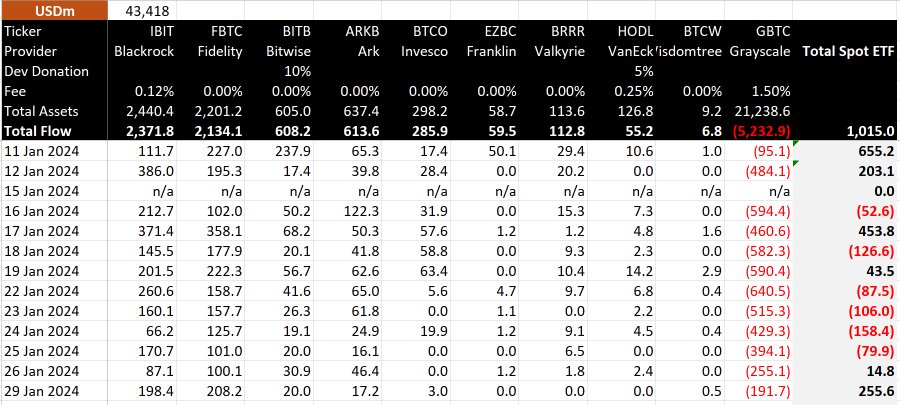Originally appeared here:
EU moves to define crypto as financial instruments, tightens rules for non-EU firms
Year: 2024
-
EU moves to define crypto as financial instruments, tightens rules for non-EU firms
The European Securities and Markets Authority (ESMA) has recently called for public feedback to help shape the criteria for classifying cryptocurrency assets as financial instruments. The latest move follows the European Parliament’s passage of the Markets in Crypto Assets (MiCA)… -
Invesco Galaxy reduced spot Bitcoin ETF commission amid competition pressure
Invesco and Galaxy Digital have announced fee reductions for their spot Bitcoin (BTC) ETF (BTCO). According to filings with the U.S. Securities and Exchange Commission, the fee is reduced by 14 basis points, from 0.39% to 0.25%. Invesco and Galaxy…Originally appeared here:
Invesco Galaxy reduced spot Bitcoin ETF commission amid competition pressure -
XRP is under pressure, whales exploring Celestia and NuggetRush
XRP is under pressure. Meanwhile, data shows that whales are exploring Celestia and NuggetRushGo here to Read this Fast! XRP is under pressure, whales exploring Celestia and NuggetRush
Originally appeared here:
XRP is under pressure, whales exploring Celestia and NuggetRush -
Global NFT market sees a 22% dip in sales, yet Trump NFTs continue to soar
The global market for NFTs has witnessed a downward trend in trading volumes, marking a consistent decline for the third week of January. According to the latest figures from CryptoSlam.io, a prominent on-chain data aggregator, the trading sales volume in…Originally appeared here:
Global NFT market sees a 22% dip in sales, yet Trump NFTs continue to soar -

Fidelity inflows smash Grayscale outflows as $255 million Bitcoin enters US market

Grayscale’s Bitcoin Trust (GBTC) is experiencing a slowdown in outflows, with just under $200 million withdrawn from the fund on Jan. 29. Data from BitMEX Research indicates a total outflow of around $192 million during this reporting period. Notably, this marks the lowest outflows since the fund’s inception, surpassing only the initial day of trading […]
The post Fidelity inflows smash Grayscale outflows as $255 million Bitcoin enters US market appeared first on CryptoSlate.
Originally appeared here:
Fidelity inflows smash Grayscale outflows as $255 million Bitcoin enters US market -
How the hike in outflows is placing Bitcoin ETFs back in the spotlight
Since approval, new spot ETFs in the U.S. have attracted net inflows worth $807 million.
Daily outflows from GBTC dropped progressively over the week.Digital asset investment funds recorded
The post How the hike in outflows is placing Bitcoin ETFs back in the spotlight appeared first on AMBCrypto.
Go here to Read this Fast! How the hike in outflows is placing Bitcoin ETFs back in the spotlight
Originally appeared here:
How the hike in outflows is placing Bitcoin ETFs back in the spotlight -
SEC sues HyperFund founders for $1.7B crypto ‘Ponzi’ scheme
HyperFund founders Lee and Chunga sued for $1.7B crypto scam. Chunga has agreed to a settlement, pending court approval, while Lee faces legal action. Additional charges have been filed by the US Attorney’s Office. The US Securities and Exchange Commission (SEC) has taken decisive legal action against individuals allegedly involved in a cryptocurrency ‘Ponzi’ scheme […]
The post SEC sues HyperFund founders for $1.7B crypto ‘Ponzi’ scheme appeared first on CoinJournal.
Go here to Read this Fast! SEC sues HyperFund founders for $1.7B crypto ‘Ponzi’ scheme
Originally appeared here:
SEC sues HyperFund founders for $1.7B crypto ‘Ponzi’ scheme -
Binance to reduce stake in Korean crypto exchange Gopax, report says
Binance reportedly plans to reduce its stake in Korean crypto exchange Gopax within the next two months to address regulatory reporting issues. Crypto exchange Binance, the major shareholder of Korean crypto trading platform Gopax, is set to reduce its stake…Go here to Read this Fast! Binance to reduce stake in Korean crypto exchange Gopax, report says
Originally appeared here:
Binance to reduce stake in Korean crypto exchange Gopax, report says -

What’s new in pandas 2.2

What’s New in Pandas 2.2
The most interesting things about the new release

Photo by Zoe Nicolaou on Unsplash pandas 2.2 was released on January 22nd 2024. Let’s take a look at the things this release introduces and how it will help us to improve our pandas workloads. It includes a bunch of improvements that will improve the user experience.
pandas 2.2 brought a few additional improvements that rely on the Apache Arrow ecosystem. Additionally, we added deprecations for changes that are necessary to make Copy-on-Write the default in pandas 3.0. Let’s dig into what this means for you. We will look at the most important changes in detail.
I am part of the pandas core team. I am an open source engineer for Coiled where I work on Dask, including improving the pandas integration.
Improved PyArrow support
We have introduced PyArrow backed DataFrame in pandas 2.0 and continued to improve the integration since then to enable a seamless integration into the pandas API. pandas has accessors for certain dtypes that enable specialized operations, like the string accessor, that provides many string methods. Historically, list and structs were represented as NumPy object dtype, which made working with them quite cumbersome. The Arrow dtype backend now enables tailored accessors for lists and structs, which makes working with these objects a lot easier.
Let’s look at an example:
import pyarrow as pa
series = pd.Series(
[
{"project": "pandas", "version": "2.2.0"},
{"project": "numpy", "version": "1.25.2"},
{"project": "pyarrow", "version": "13.0.0"},
],
dtype=pd.ArrowDtype(
pa.struct([
("project", pa.string()),
("version", pa.string()),
])
),
)This is a series that contains a dictionary in every row. Previously, this was only possible with NumPy object dtype and accessing elements from these rows required iterating over them. The struct accessor now enables direct access to certain attributes:
series.struct.field("project")
0 pandas
1 numpy
2 pyarrow
Name: project, dtype: string[pyarrow]The next release will bring a CategoricalAccessor based on Arrow types.
Integrating the Apache ADBC Driver
Historically, pandas relied on SqlAlchemy to read data from an Sql database. This worked very reliably, but it was very slow. Alchemy reads the data row-wise, while pandas has a columnar layout, which makes reading and moving the data into a DataFrame slower than necessary.
The ADBC Driver from the Apache Arrow project enables users to read data in a columnar layout, which brings huge performance improvements. It reads the data and stores them into an Arrow table, which is used to convert to a pandas DataFrame. You can make this conversion zero-copy, if you set dtype_backend=”pyarrow” for read_sql.
Let’s look at an example:
import adbc_driver_postgresql.dbapi as pg_dbapi
df = pd.DataFrame(
[
[1, 2, 3],
[4, 5, 6],
],
columns=['a', 'b', 'c']
)
uri = "postgresql://postgres:postgres@localhost/postgres"
with pg_dbapi.connect(uri) as conn:
df.to_sql("pandas_table", conn, index=False)
# for round-tripping
with pg_dbapi.connect(uri) as conn:
df2 = pd.read_sql("pandas_table", conn)The ADBC Driver currently supports Postgres and Sqlite. I would recommend everyone to switch over to this driver if you use Postgres, the driver is significantly faster and completely avoids round-tripping through Python objects, thus preserving the database types more reliably. This is the feature that I am personally most excited about.
Adding case_when to the pandas API
Coming from Sql to pandas, users often miss the case-when syntax that provides an easy and clean way to create new columns conditionally. pandas 2.2 adds a new case_when method, that is defined on a Series. It operates similarly to what Sql does.
Let’s look at an example:
df = pd.DataFrame(dict(a=[1, 2, 3], b=[4, 5, 6]))
default=pd.Series('default', index=df.index)
default.case_when(
caselist=[
(df.a == 1, 'first'),
(df.a.gt(1) & df.b.eq(5), 'second'),
],
)The method takes a list of conditions that are evaluated sequentially. The new object is then created with those values in rows where the condition evaluates to True. The method should make it significantly easier for us to create conditional columns.
Copy-on-Write
Copy-on-Write was initially introduced in pandas 1.5.0. The mode will become the default behavior with 3.0, which is hopefully the next pandas release. This means that we have to get our code into a state where it is compliant with the Copy-on-Write rules. pandas 2.2 introduced deprecation warnings for operations that will change behavior.
df = pd.DataFrame({"x": [1, 2, 3]})
df["x"][df["x"] > 1] = 100This will now raise a FutureWarning.
FutureWarning: ChainedAssignmentError: behaviour will change in pandas 3.0!
You are setting values through chained assignment. Currently this works in certain cases, but when
using Copy-on-Write (which will become the default behaviour in pandas 3.0) this will never work to
update the original DataFrame or Series, because the intermediate object on which we are setting
values will behave as a copy. A typical example is when you are setting values in a column of a
DataFrame, like:
df["col"][row_indexer] = value
Use `df.loc[row_indexer, "col"] = values` instead, to perform the assignment in a single step and
ensure this keeps updating the original `df`.I wrote an earlier post that goes into more detail about how you can migrate your code and what to expect. There is an additional warning mode for Copy-on-Write that will raise warnings for all cases that change behavior:
pd.options.mode.copy_on_write = "warn"
Most of those warnings are only noise for the majority of pandas users, which is the reason why they are hidden behind an option.
pd.options.mode.copy_on_write = "warn"
df = pd.DataFrame({"a": [1, 2, 3]})
view = df["a"]
view.iloc[0] = 100This will raise a lengthy warning explaining what will change:
FutureWarning: Setting a value on a view: behaviour will change in pandas 3.0.
You are mutating a Series or DataFrame object, and currently this mutation will
also have effect on other Series or DataFrame objects that share data with this
object. In pandas 3.0 (with Copy-on-Write), updating one Series or DataFrame object
will never modify another.The short summary of this is: Updating view will never update df, no matter what operation is used. This is most likely not relevant for most.
I would recommend enabling the mode and checking the warnings briefly, but not to pay too much attention to them if you are comfortable that you are not relying on updating two different objects at once.
I would recommend checking out the migration guide for Copy-on-Write that explains the necessary changes in more detail.
Upgrading to the new version
You can install the new pandas version with:
pip install -U pandas
Or:
mamba install -c conda-forge pandas=2.2
This will give you the new release in your environment.
Conclusion
We’ve looked at a couple of improvements that will improve performance and user experience for certain aspects of pandas. The most exciting new features will come in pandas 3.0, where Copy-on-Write will be enabled by default.
Thank you for reading. Feel free to reach out to share your thoughts and feedback.
What’s new in pandas 2.2 was originally published in Towards Data Science on Medium, where people are continuing the conversation by highlighting and responding to this story.
Originally appeared here:
What’s new in pandas 2.2
